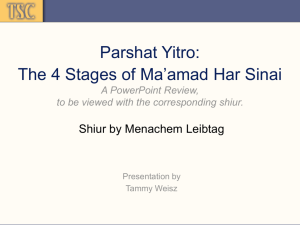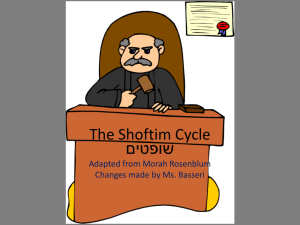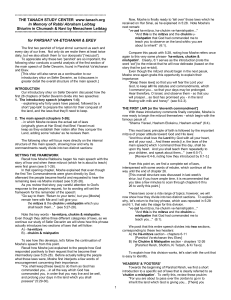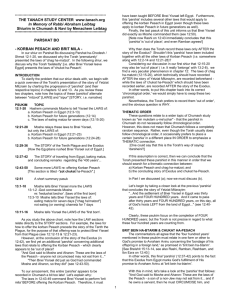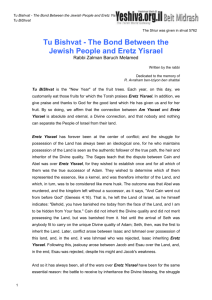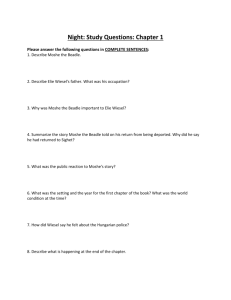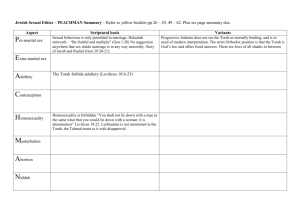during
advertisement
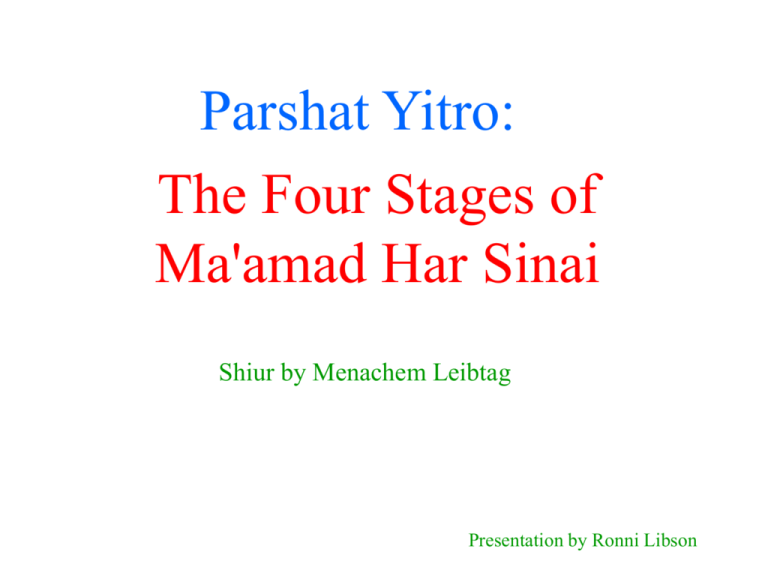
Parshat Yitro: The Four Stages of Ma'amad Har Sinai Shiur by Menachem Leibtag Presentation by Ronni Libson Chapter 19 4 sections: I. Proposition (19:1-8) II. Preparation (19:9-15) III. Revelation (19:16-19) IV. Limitation (19:20-25) Proposition (19:1-8) If: You will obey Me faithfully and keep My Covenant Then: You shall be for Me a 'mamlechet Kohanim v'goy kadosh.." Theme of Sefer Breishit: Bnei Yisrael will be a 'model' nation ------ to represent God ----------------------------------to all mankind --------------------------------------------------Before receiving Torah Bnei Yisrael must: Confirm readiness to obey God's commandments Recognize that mitzvot will facilitate achievement of Divine goal Bnei Yisrael accept these terms: Preparation (19:9-15) Next step after accepting proposal - receive mitzvot God first addresses how Bnei Yisrael will receive mitzvot: Moshe will be intermediary conveying mitzvot to Bnei Yisrael Bnei Yisrael will 'overhear' God's communion with Moshe to strengthen belief that laws come from God Expect Moshe to convey message to Bnei Yisrael (as in 19:7) Instead: Never tells what Bnei Yisrael responded, just that Moshe relayed the people's response back to God! Rashi Adds line to narrative: Bnei Yisrael don't accept original plan Demand to hear the Dibrot directly from God Structure of pasuk: Bnei Yisrael’s response (second half) relates to God's plan for Matan Torah (first half) Look at God's response to understand Bnei Yisrael's request: New plan for Matan Torah! Plan A: Moshe will act as intermediary (19:9) Plan B: Bnei Yisrael themselves will see God (19:11) Change of plan Now Bnei Yisrael require 3 days of preparation - higher level of spiritual readiness Can Bnei Yisrael reach this level? If so, why doesn't God suggest this in the first place? If not, why does God now agree to their request? Revelation (19:16-19) Plan A or Plan B? Intensity of "hitgalut" - may reflect intense level of Plan B Description of a "thick cloud" covering Har Sinai - God's description of Plan A (19:9) Bnei Yisrael frightened Remain in camp rather than gather at Har Sinai Moshe brings them from camp to Har Sinai: Description of "hitgalut": Mountain covered with smoke - Plan A God's descent onto the mountain - Plan B What was Moshe saying? What was God answering? If Moshe was saying Dibrot Plan A (Moshe intermediary, people 'overhearing' a “kol” from God) If not What is Moshe saying and what is God answering? Rashi: First two Commandments Plan B Last eight Commandments Plan A Pasuk refers to last 8 commandments Ramban: Pasuk describes conversation between God and Moshe recorded in psukim that immediately follow (19:20-25) Limitation (19:20-25) Plan A: God appears at top of mountain to Moshe alone Bnei Yisrael prohibited from seeing "lest they die" God limits His revelation to the top of the Mountain Another story at Har Sinai: God reverts from Plan B back to Plan A People were frightened and overwhelmed by intense experience of "hitgalut" Story of Bnei Yisrael being frightened - “yirah” story Out of place! Should be in chapter 19, not chapter 20 Ramban: Entire “yirah” parshia (20:15-18) took place earlier, before Matan Torah Described in Devarim: Explains why immediately afterward in chapter 19 are a set of psukim describing this limitation of God's "hitgalut" before Matan Torah actually begins Rashi and Chizkuni: The “yirah” story (20:15-18 ) took place during Matan Torah, between the first two and last eight commandments First two Commandments (20:2-5) first person God commands Bnei Yisrael directly Explains transplantation of “yirah” story from chronological location to chapter 20 Last eight Commandments (20:6-14) third person Less direct form of communication – through Moshe Cannot record it before Dibrot (story took place during Dibrot) Cannot record it in proper place (cannot break up the Dibrot, a single unit) Torah records it immediately after the Ten Commandments Description of Matan Torah in Devarim: Plan B Plan A Both plans were carried out Why is Torah unclear as to the details of Matan Torah? Ambiguity intentional Reflects the very nature of man's encounter with the Divine Must constantly strive to come as close to God as possible “ahava” Must constantly retain an awareness of God's greatness and recognize his own shortcomings and unworthiness “yirah” Man Plan A God's original plan for Matan Torah Man is unable to directly confront the "Shchinah" Uses Moshe as an intermediary Plan B Bnei Yisrael’s request Desire to come as close as possible to Har Sinai and to encounter the "Shchina" directly Plan B - Ideal Expression of "ahavat Hashem" Plan A - Reality Ambiguity in Torah’s presentation Torah emphasizes the need to find the proper balance between realism and idealism when serving God Why does God give in to Bnei Yisrael’s request? Bnei Yisrael – similar to a child Despite clear incapability to perform a given task, desire to accomplish is the key to growth Wise parent will allow child to try even though child will fail Better one recognize the limits of his capabilities on his own rather than be told by others that he cannot accomplish As Bnei Yisrael struggle to maintain the proper balance between "ahava" and "yirah," God must guide and they must strive
